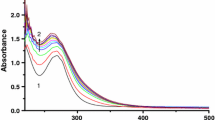Synopsis
Polyanions at the nodes of Ranvier of peripheral nerve fibres have been studied with cationic ‘stais’ including colloidal iron, inorganic salts and Alcian Blue. The various cations were found to differ in their interactions with tissue macromolecules. Such differences have been examined critically in an attempt to understand the underlying physico-chemical principles involved in the histochemical demonstration of acidic macromolecules. In addition, certain phenomena associated with polyanions, such as ion-exchange, demonstrated in the present study, are discussed in relation to the possible physiological function of such macromolecules at nodes of Ranvier in the conduction of the nerve impulse.
Similar content being viewed by others
References
Abood, L. G. &Abul-Haj, S. F. (1956). Histochemistry and characterisation of hyaluronic acid in axons of peripheral nerve.J. Neurochem. 1, 119–25.
Allt, G. (1968). M.Phi, Dissertation, London.
Bondareff, W. (1967). An intercellular substance in rat cerebral cortex: submicroscopic distribution of ruthenium red.Anat. Rec. 157, 527–36.
Bungenberg De Jong (1949). Reversal of charge phenomena, equivalent weight and specific properties of ionised groups. InColloid Science, Vol. 2, ed. H. R. Kruyt, pp. 259–334. New York, Elsevier.
Curran, R. C., Clark, A. E. &Lovell, D. (1965). Acid mucopolysaccharides in electron microscopy. The use of the colloidal iron method.J. Anat. 99, 427–34.
Casic, G. &Berwick, L. (1962). Hale stain for sialic acid containing muicins adaptation to electron microscopy.J. Cell Biol. 19, 223–8.
Croniowski, J., Biczyskowa, W. &Walski, M. (1969). Electron microscope studies on the surface coat of the nephron.J. Cell Biol. 40, 585–601.
Hale, G. W. (1946). Histochemical demonstration of acid polysaccharides in animal tissues.Nature 157, 802.
Landon, D. N. &Langley, O. K. (1969). Cationic binding of the node of Ranvier.J. Anat. 105, 196.
Landon, D. N. &Langley, O. K. (1971). The local chemical environment of the node of Ranvier.J. Anat. 108, 419–32.
Langley, O. K. (1969). Ion exchange at the node of Ranvier.Histochem. J. 1, 295–309.
Langley, O. K. (1970). The interaction between peripheral nerve polyanions and Alcian Blue.J. Neurochem..17, 1535–41.
Langley, O. K. &Landon, D. N. (1969). A light and electron histochemical approach to the node of Ranvier and myelin of peripheral nerve fibres.J. Histochem. Cytochem. 15, 722–31.
Langley, O. K. &Landon, D. N. (1969). Copper binding at nodes of Ranvier: a new electron histochemical technique for the demonstration of polyanions.J. Histochem. Cytochem. 17, 66–9.
Luft, J. H. (1966). Fine structure of capillary and endocapillary layer as revealed by ruthenium red.Fed. Proc. 25, 1773–83.
Pearse, A. G. E. (1960).Histochemistry: Theoretical and Applied, 2nd Ed, pp. 259–61. London, Churchill.
Rambourg, A. &Leblond, C. P. (1967). Electron microscope observations on the carbohydrate-rich cell coat present at the surface of cells in the rat.J. Cell Biol. 32, 27–53.
Salminen, S. &Loumanmäki, K. (1963). The binding of sodium and potassium ions by heparin.Biochim. biophys. Acta 69, 533–7.
Scott, J. E. (1967), Patterns of specificity in the interaction of organic cations with acid mucopolysaccharides. InThe Chemical Physiology of Mucopolysaccharides, ed. G. Quintarelli, pp. 219–31. Boston: Little, Brown.
Scott, J. E. &Willett, I. H. (1966). Binding of cationic dyes to nucleic acids and other biological polyanions.Nature 209, 985–7.
Spicer, S. S. &Lillie, R. D. (1959). Saponification as a means of selectively reversing the methylation blockade of tissue basophilia.J. Histochem. Cytochem. 7, 123–5.
Weiss, L. (1962). The mammalian tissue cell surface.Biochem. Soc. Symp. 22, 32–54.
Wetzel, M. G., Wetzel, B. K. &Spicer, S. S. (1966). Ultrastructural localization of acid mucosubstances in the mouse colon with iron-containing stains.J. Cell Biol. 30, 299–315.
Williams, P. L. &Landon, D. N. (1964). The energy source of the nerve fibre.New Scientist 21, 166–9.
Author information
Authors and Affiliations
Rights and permissions
About this article
Cite this article
Langley, O.K. A comparison of the binding of Alcian Blue and inorganic cations to polyanions in peripheral nerve. Histochem J 3, 251–260 (1971). https://doi.org/10.1007/BF01005224
Received:
Issue Date:
DOI: https://doi.org/10.1007/BF01005224




